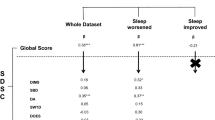Abstract
The objective of this study was to evaluate associations between sleep problems and psychiatric symptoms at school. A random sample consisting of 5813 eight- to nine-year-old children was selected from ordinary schools. Both parents' and children's reports of sleep problems were taken into account. The psychiatric symptoms were addressed according to the teachers' reports (the Rutter Scale B). Children with severe sleep problems were more likely to have a psychiatric disturbance according to the Rutter B Scale (OR 2.45, 95 % CI 1.85–3.25). Logistic regression models showed that severe sleep problems were highly associated with emotional problems (OR 2.74, 95 % CI 1.84–4.13), school attendance problems (OR 2.53, 95 % OR 1.45–4.41), behavioural problems (OR 2.44, 95 % CI 1.59–3.75) and hyperactivity (OR 2.02, 95 % CI 1.30–3.13). Over 95 % of severe sleep problems were reported only by the children themselves. In conclusion, children with severe sleep problems have substantially more teacher-reported psychiatric symptoms than those with no or mild sleep complaints. In diagnosing sleep disorders, it is important to include children as informants because relevant information may be overlooked when only parents are questioned.
Similar content being viewed by others

Author information
Authors and Affiliations
Additional information
Accepted: 20 August 2001
Rights and permissions
About this article
Cite this article
Paavonen, E., Almqvist, F., Tamminen, T. et al. Poor sleep and psychiatric symptoms at school: an epidemiological study. European Child & Adolescent Psychiatry 11, 10–17 (2002). https://doi.org/10.1007/s007870200002
Issue Date:
DOI: https://doi.org/10.1007/s007870200002



